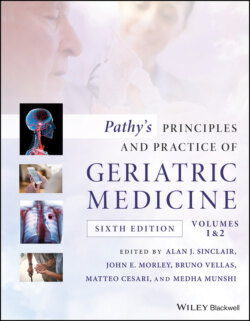Читать книгу Pathy's Principles and Practice of Geriatric Medicine - Группа авторов - Страница 531
Inflammatory diseases of the pancreas Acute pancreatitis
ОглавлениеIn the United States, the incidence of acute pancreatitis increased from 65 to 81 per 100,000 adults annually between 2001 and 2014. In the hospital, case fatalities have decreased from 1.68 to 0.69%, but mortality rates were higher in persons older than 65.2
Although alcohol abuse is a major cause of acute pancreatitis in adults, it is somewhat less common as a cause in the elderly. Acute pancreatitis, however, occurs with increasing frequency in the elderly because of an increased prevalence of gallstones and biliary sludge. In addition to alcohol and gallstones, other predisposing factors for acute pancreatitis in the elderly include hypercalcemia (usually due to hyperparathyroidism), hypertriglyceridemia, and obstruction to pancreatic flow caused by a pancreatic tumour. Acute pancreatitis occurs in some patients following cardiac bypass and cardiac valve surgery, although asymptomatic elevations in lipase or amylase are more common and may not be of clinical significance. 15–25% of pancreatitis episodes are categorized as idiopathic. Cholecystectomy has been shown to reduce recurrence of idiopathic pancreatitis, suggesting that some ‘idiopathic’ pancreatitis may be due to microlithiasis.
In the elderly – and indeed, in all patients – medications are often considered as a possible cause of pancreatitis when no other cause is identified. In fact, with the exception of a small group of anti‐retroviral and immunomodulator medications, true drug‐related pancreatitis is likely very uncommon. Most reports of drug‐related pancreatitis are anecdotal, and the potential severity of the disease precludes drug challenges. A large retrospective German study of acute pancreatitis implicated drugs as a possible cause in only 1.4% of pancreatitis patients.3
Finally, autoimmune pancreatitis can be seen in the elderly, but rather than presenting as acute pancreatitis more often presents as a suspected pancreatic mass, with or without painless jaundice, raising concern for adenocarcinoma.4 There are two recognized entities of this condition: Type 1 and 2. Type 1, also known as IgG4‐related pancreatitis, is more prevalent in the older population. On imaging, it is typically characterized by a diffuse ‘sausage‐shaped’ pancreatic enlargement with an irregular narrow pancreatic duct. Histologically, there is lymphoplasmacytic infiltrate with ‘swirling fibrosis’ and obliterative phlebitis. The tissue stains positive for IgG4‐positive cells. Serum levels of IgG4 are often elevated (typically to at least two times the upper limit of normal). Extra‐pancreatic involvement can be seen, including biliary stricturing, retroperitoneal fibrosis, mediastinal lymphadenopathy, and infiltration of the kidneys, salivary glands, and parotids. This condition is typically highly responsive to steroid treatment.
